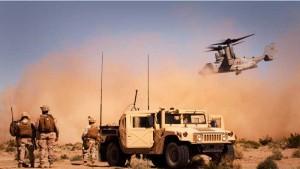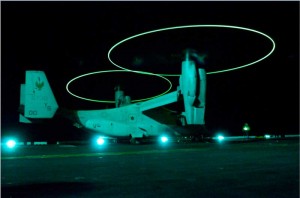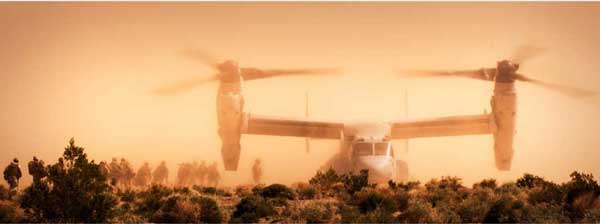By Vince Martinez
Vince Martinez is a regular contributor to SLD and is the President and Founder of Affinity Fidelis Consulting and Technologies; a defense consulting firm in Northern Virginia.
The successful deployment of both V-22 tilt-rotor variants for the U.S. Marine Corps and the Air Force Special Operations Command to various theaters in the Middle East will force the defense industry, along with military forces worldwide, to accept that powered-lift is now an effective and operational capability. And this capability has brought with it an evolutionary leap forward for rotary wing operations.
With the operating characteristics of a typical helicopter and the efficiencies, capacities, and capabilities of a turbo-prop aircraft, the Osprey has successfully integrated the benefits of both types of platforms into a futuristic, hybrid aircraft.
As many will attest, the fielding of these powered-lift platforms has been challenging at times; indeed many would continue to argue that there are still many issues that need to be resolved with this type of technology.
One thing is certain, though: the battlefield has changed as a result of this technology and the benefits of speed, range, and capacity of the first powered-lift transport (the V-22 Osprey) over traditional medium-lift rotorcraft now must be considered by military decision-makers as they move toward defining a future for their rotary wing forces.
It is precisely because of these unprecedented deployments, and because of the successful operational history of predecessor platforms like the AV-8 Harrier, that powered-lift has now earned its rightful place in aviation history.
Powered-lift aircraft should be considered closely by all for its role in the future aviation spectrum.
In July 2007, the U. S. Defense Science Board (DSB) cited the need for Vertical Take-Off and Landing (VTOL) and Short Take-Off and Landing (STOL) aircraft so that the military can meet the demands of the 21st century. Although the study focused primarily on transport aircraft, specifically in addressing many of the shortfalls of transporting the Army’s Future Combat System (FCS), the lessons drawn from their conclusions are equally compelling across other types of aircraft.

Reeling from heavy combat losses for helicopters in both Iraq and Afghanistan, the performance enhancements of a hybrid aircraft like the Osprey could have possibly prevented some of the losses, according to the DSB. With the ability to fly above or around a significant portion of the ground-based threat, along with the many survivability enhancements that come with a modern aircraft, the benefits of powered-lift in the future were more apparent with every rotary wing loss.
Although aircraft survivability was certainly a significant component of their findings, the study was also clear in defining that the future role for VTOL/STOL transports really had much more to do with enhancements for maneuvering ground forces rather than simply aircraft survivability. The appeal of having a family of VTOL/STOL transports of all sizes simplified, in their minds, many maneuver and sustainment issues associated with forces of the 21st century, and were key to solving multiple dilemmas for both ground and sea-based resources – many of which are relevant issues even today.
As the battlespace continues to expand, and as operational requirements dictate the necessity to influence entire regions vice specific area of operations, it is clear that the maneuvering forces of the future will demand additional aviation capabilities in terms of range, speed, lift, kinetic and non-kinetic delivery, and command and control in order to support a newly expanded operational reach.
VTOL/STOL aircraft will be part of that solution, and will allow warfighters to do exactly that: operate at extended distances while providing the same types of objective area impacts that are expected of a modern force. These platforms will enhance the ability of the military to influence a myriad of climates and places, at distances unprecedented by legacy platforms, with minimal losses to the effectiveness of ground force in terms of maneuverability, sustainment, or delivery of fires. Ground forces will be free to move rapidly without the need for significant infrastructure to support their aviation element, and will be able to keep their aviation assets in closer proximity to the battlefront.
 The warfighter will also be better postured to react to the unknown by having tighter control over their aviation resources – simply due to enhanced flexibility of a VTOL/STOL force – and will have the ability to tailor their aviation assets more readily for the fight at hand.
The warfighter will also be better postured to react to the unknown by having tighter control over their aviation resources – simply due to enhanced flexibility of a VTOL/STOL force – and will have the ability to tailor their aviation assets more readily for the fight at hand.
There are other benefits to VTOL/STOL:
- transit times for re-supply will be truncated,
- subsequent maneuver will become less challenging,
- intangibles like replacement of aircrew and length of “crew day” are maximized due to the aviation element being in close proximity to the actual fight,
- quick turnarounds for refueling and reloading, and
- response times for time-critical mission sets like casualty evacuation will be cut in half due to not only the close proximity of VTOL/STOL aircraft, but also due to the speed and range of these types of hybrid platforms.
Additionally, with the ability for many of these platforms to operate in maritime environments, advancing from a sea-base can also circumvent restrictions that typically inhibit land-based or overwater transit, which also adds to increased operational flexibility.

While there are those who will remain distracted with the metrics of performance for singular platforms, it is clear that a larger strategic picture has emerged which has defined a significant role for VTOL/STOL in the future. Whether these aircraft manifest in the form of transports, fighter/attack aircraft, or Unmanned Aircraft Systems (UAS), the measuring stick for the efficacy of these platforms must be shifted to the ground forces that they will ultimately support.
Questions regarding their utility in the future battlespace should be approached from the proper perspective:
- What are we asking our operational forces to accomplish;
- How do we maximize our investment in terms of operational flexibility and tactical agility with limited resources; and
- What makes the most sense in terms of fiscal investment with our uncertain political climates, ever-changing operational requirements, and in a world where the military is continually being asked to accomplish more with less?
VTOL/STOL will never be the panacea that will tilt aviation toward what was espoused by “Billy” Mitchell’s or Giulio Douhet’s visions of air dominance. But when combined effectively with other martial capabilities across the operational spectrum, the benefits of fielding VTOL/STOL aircraft that are capable of accomplishing a myriad of tasks while operating across a wide array of tactical environments and scenarios, will truly have a tangible impact on the ground commander’s ability to influence and control the future battlespace.
For the visionaries, now is the time to start looking toward the “what next” with VTOL/STOL aircraft and that is largely due to the fact that powered-lift has now successfully earned a right to have a seat at the table.
———-
***Posted June 9th, 2010


